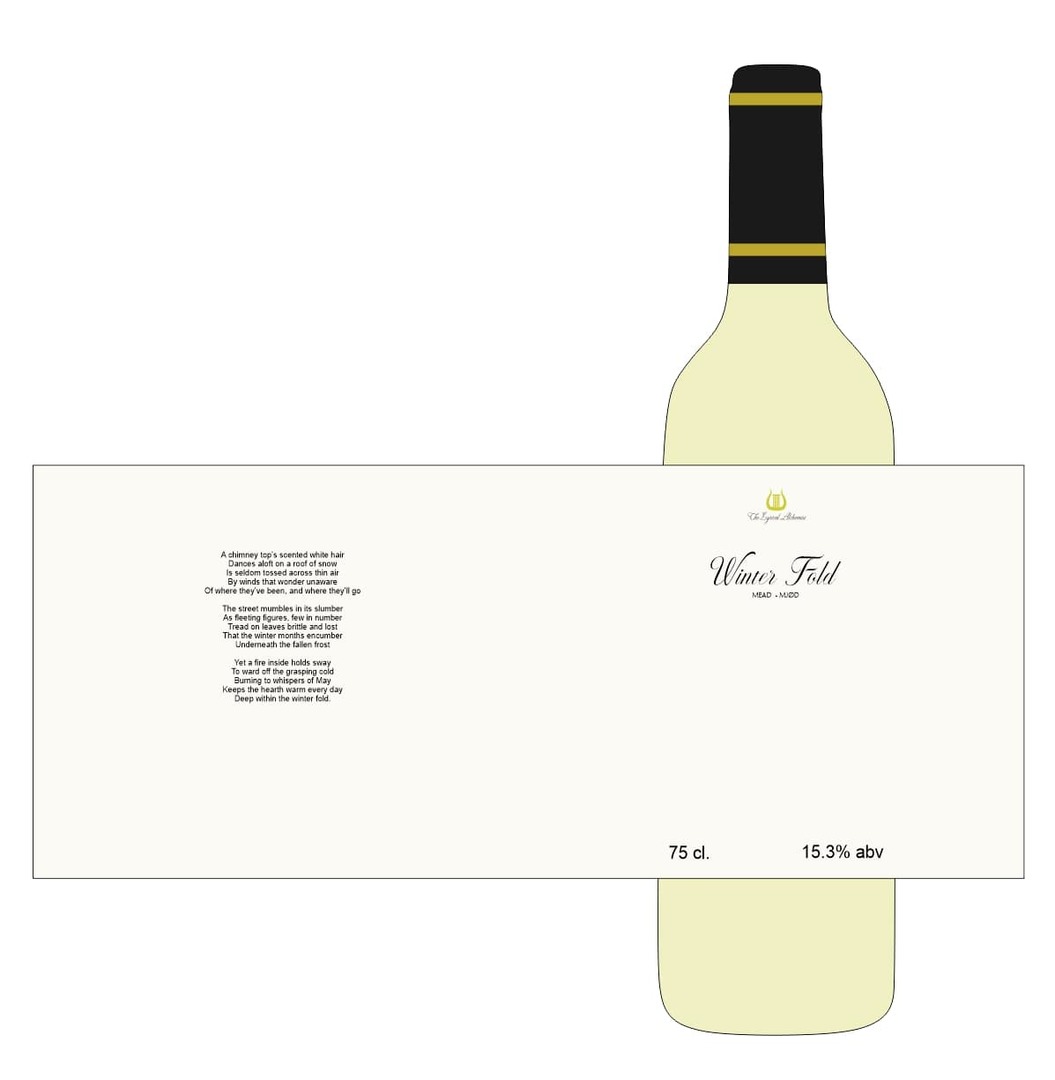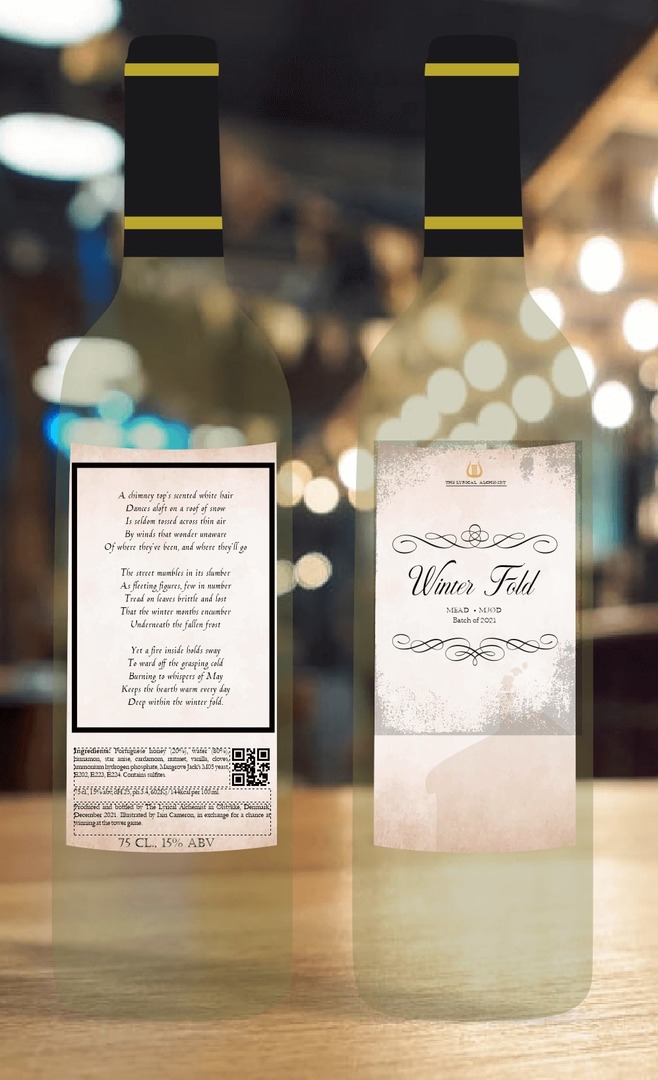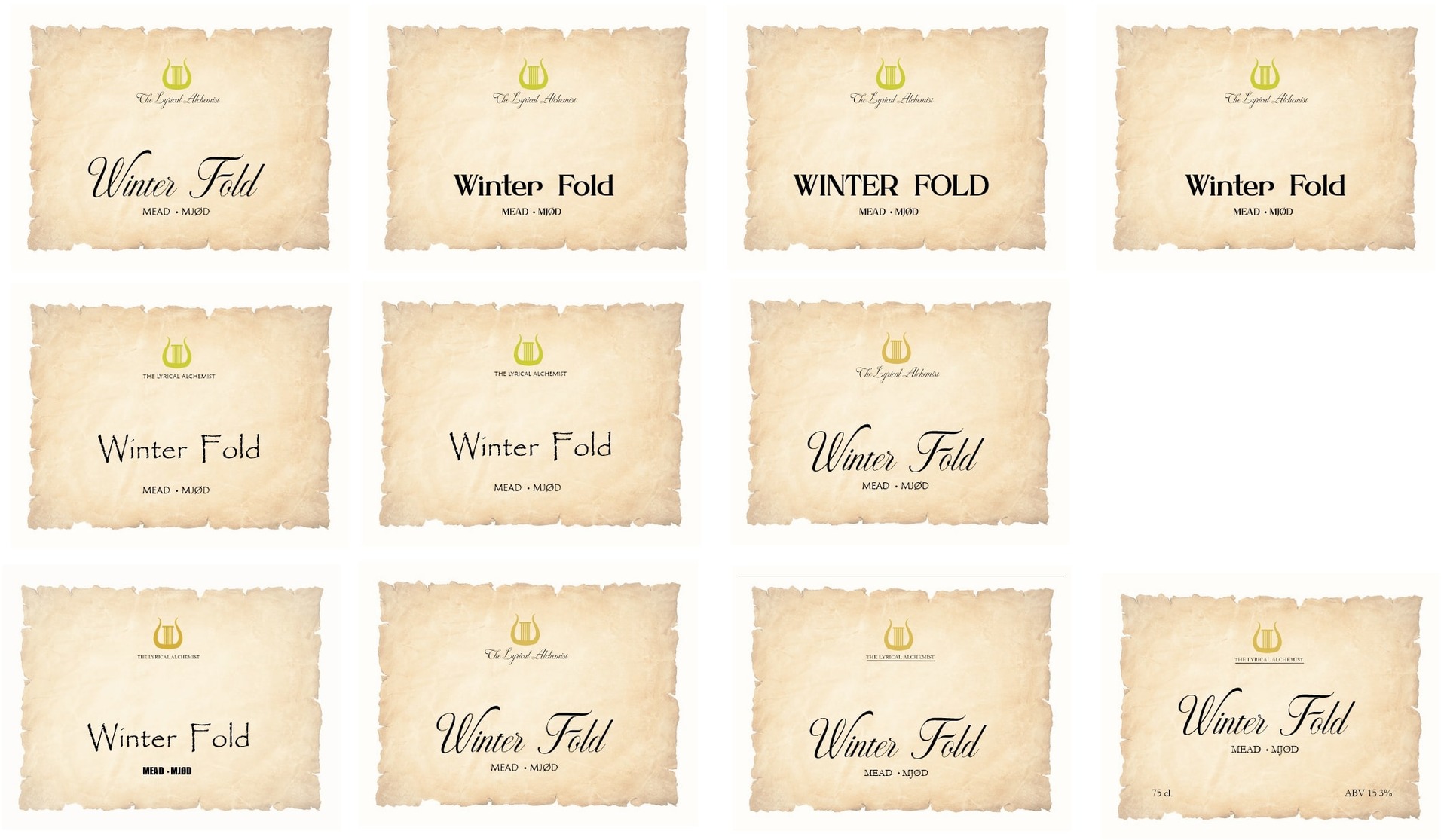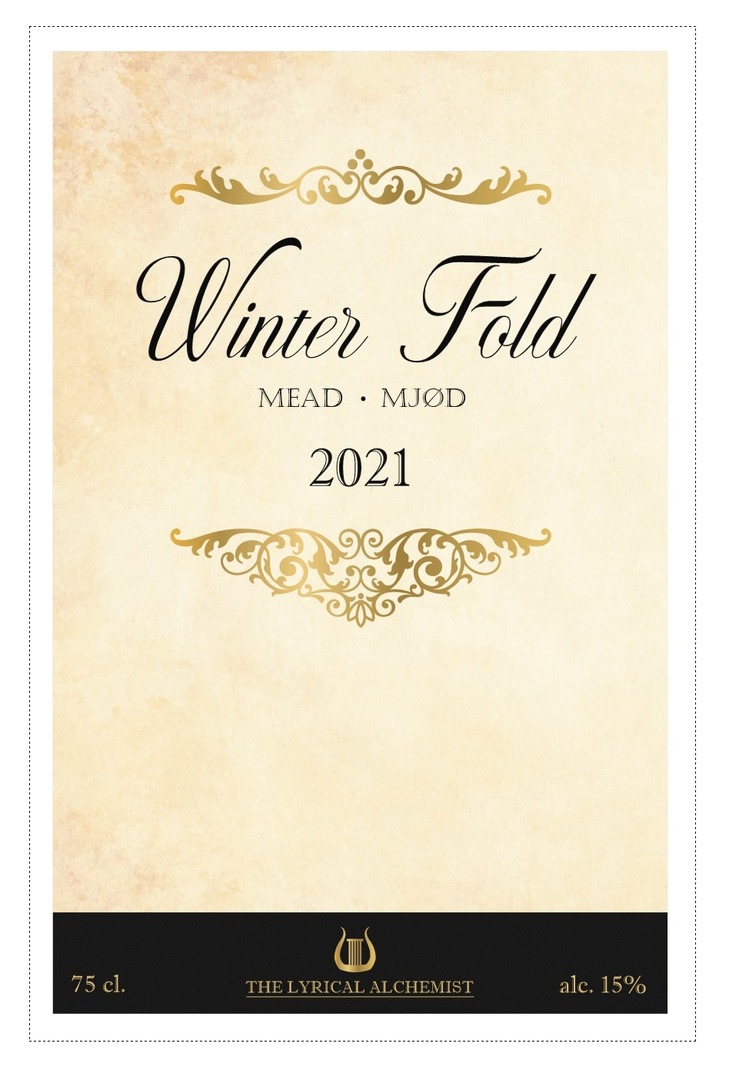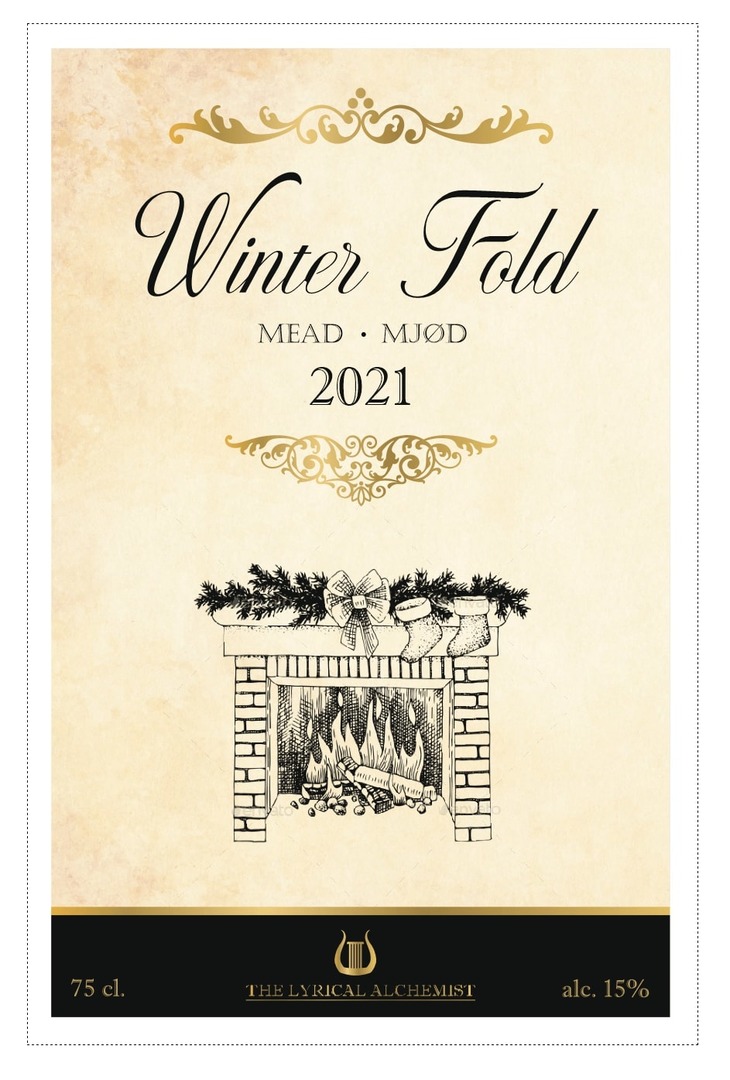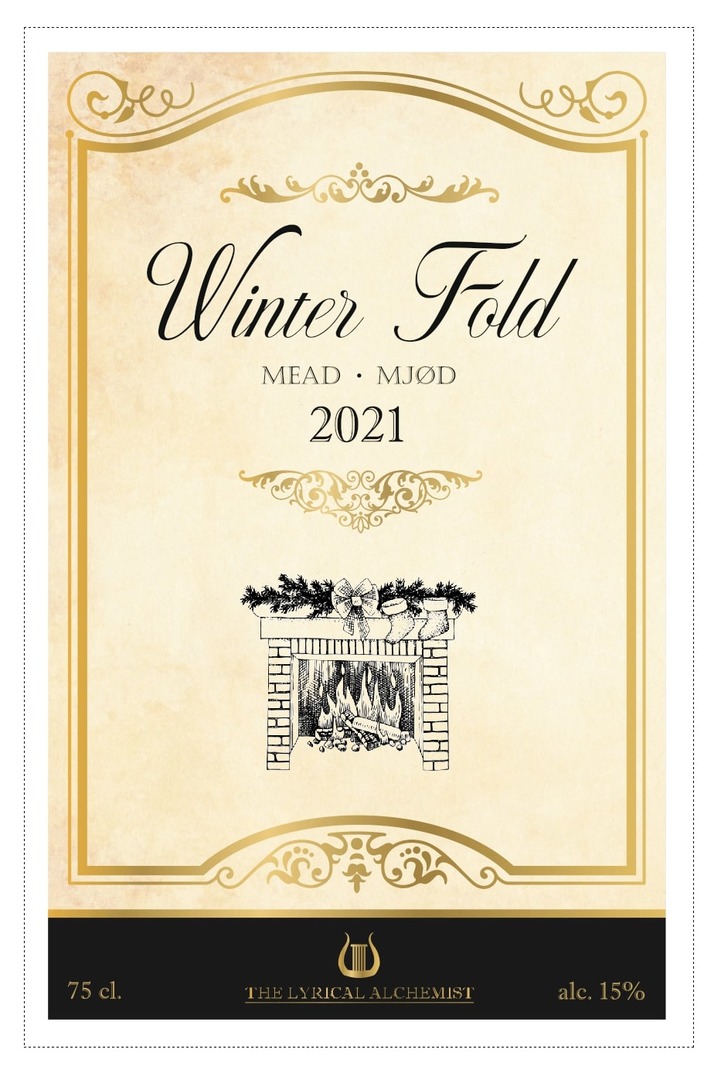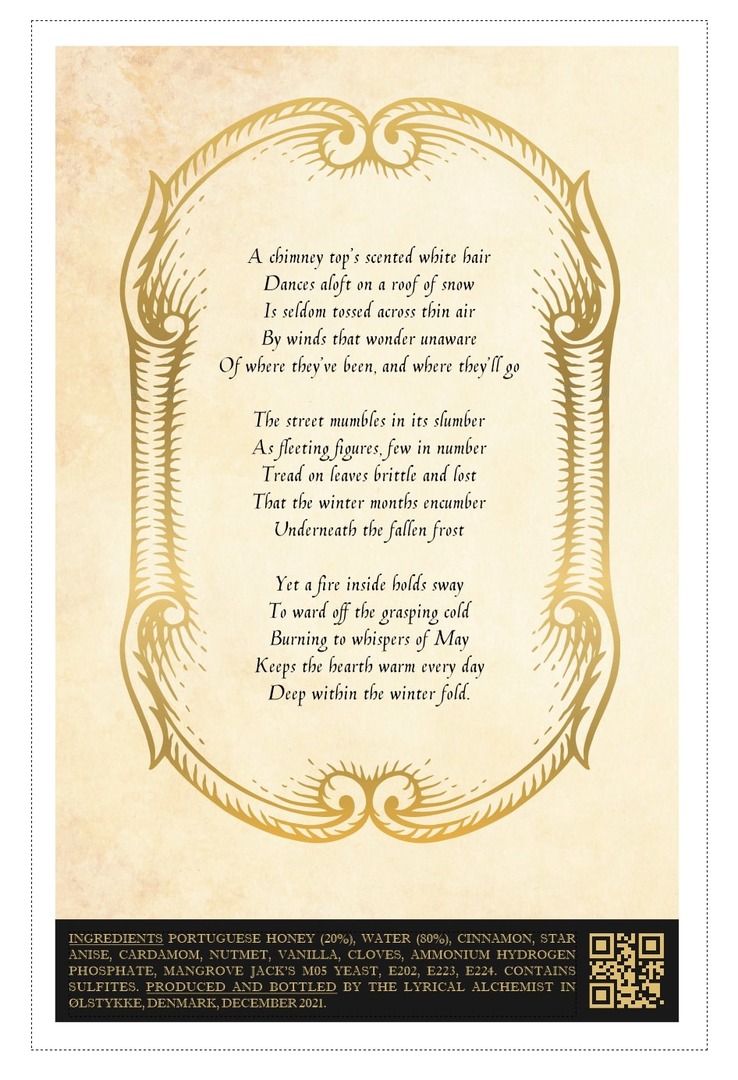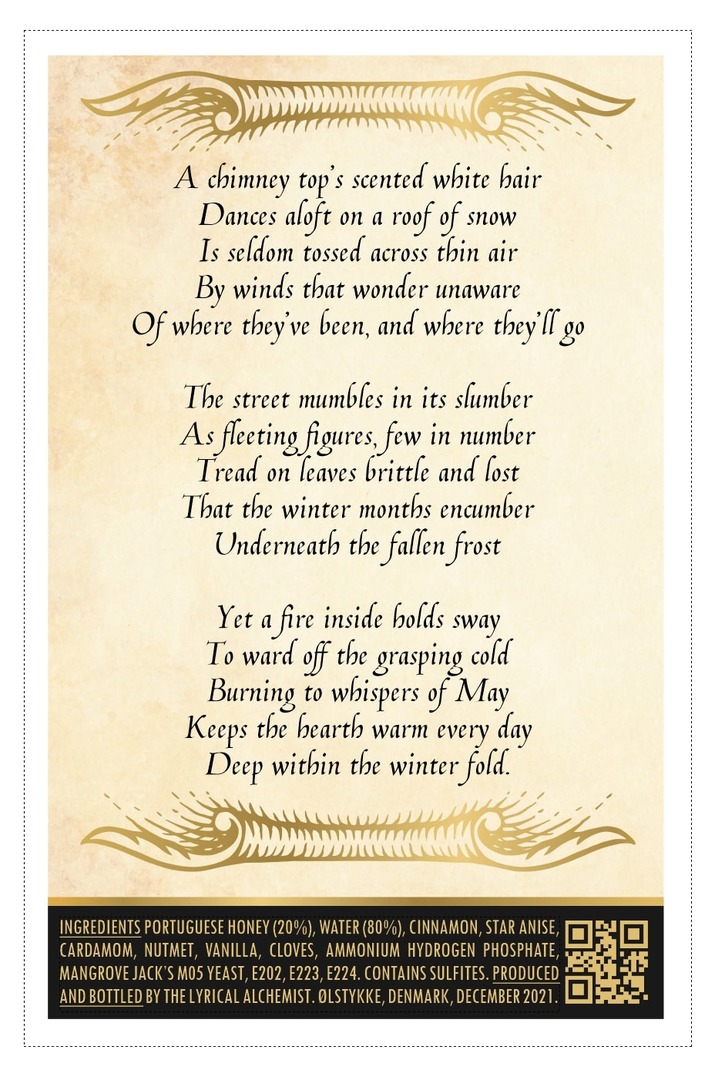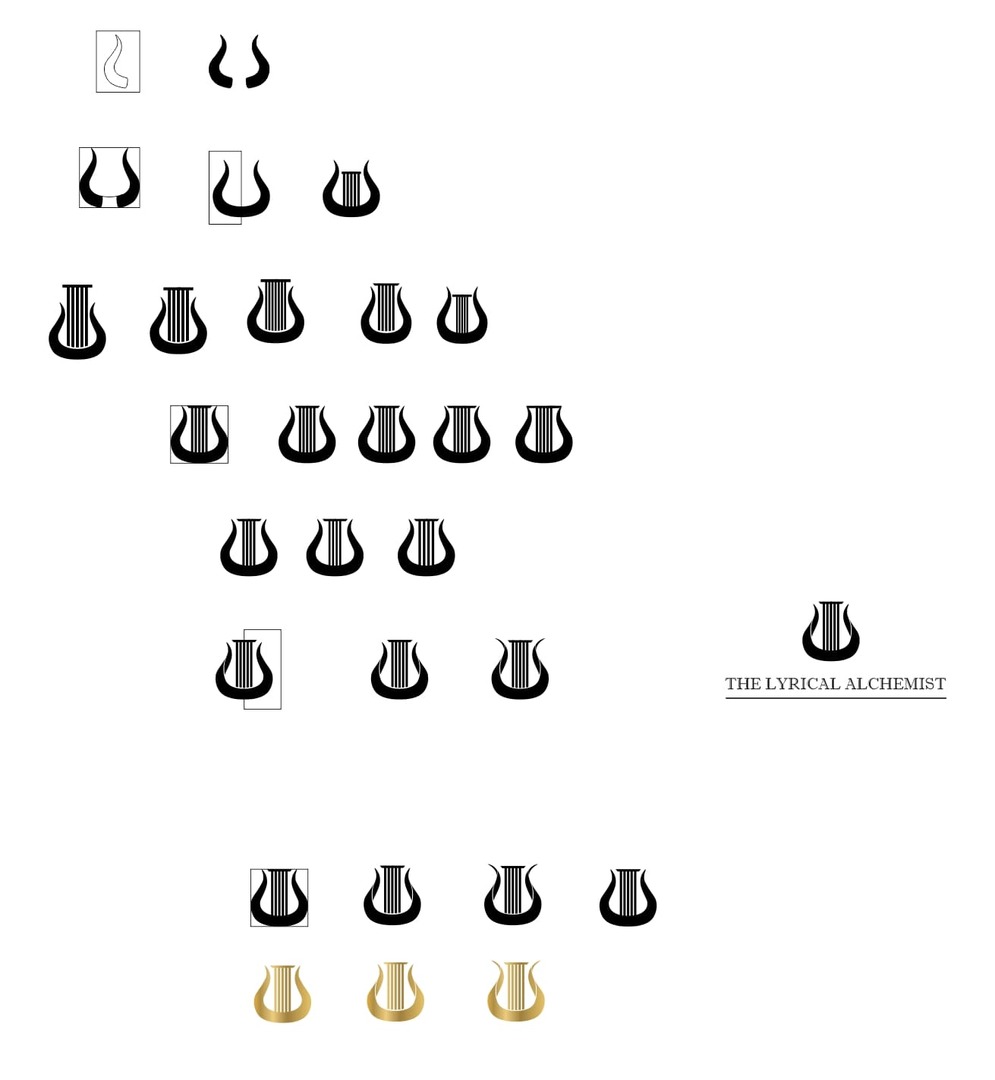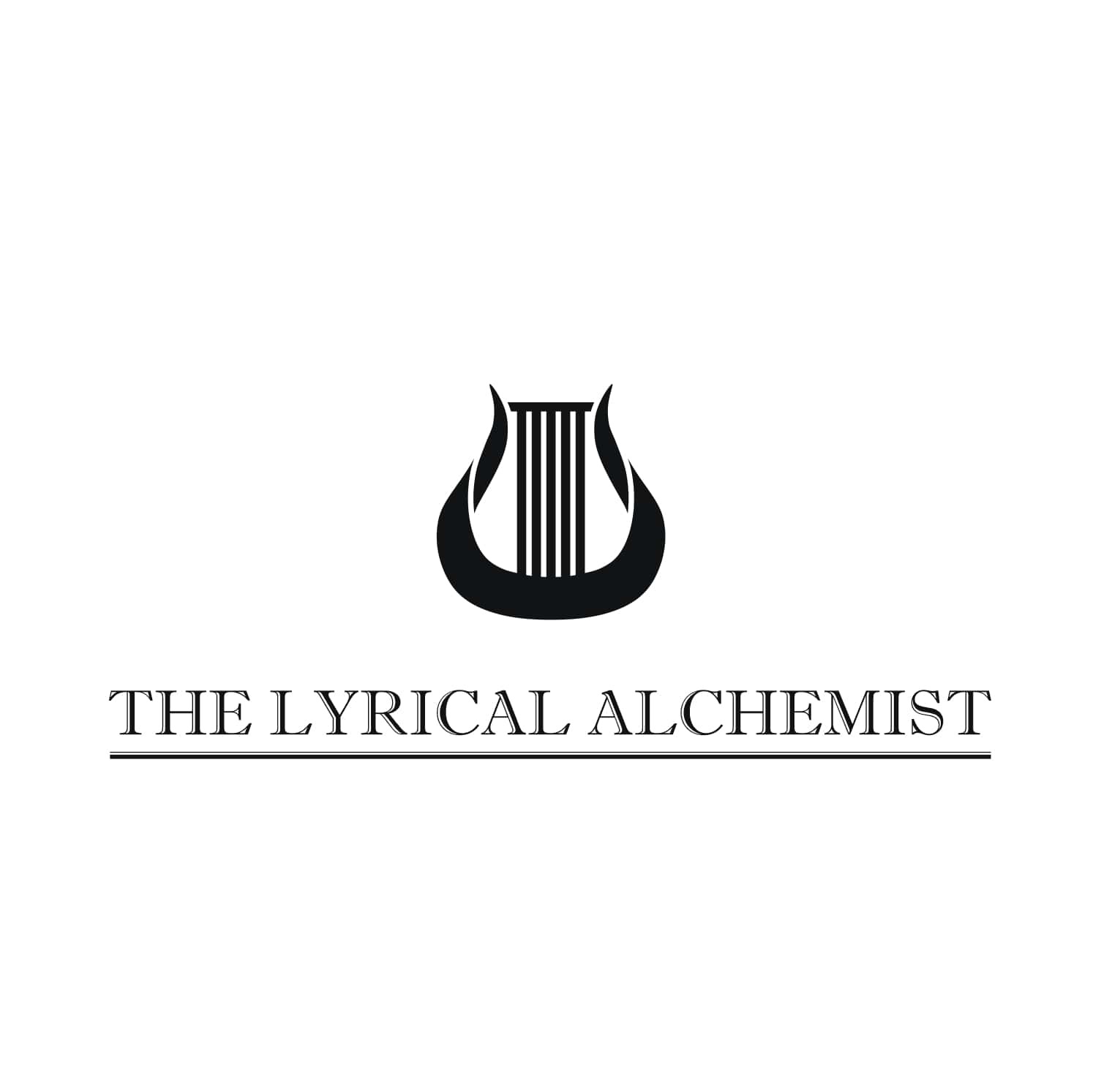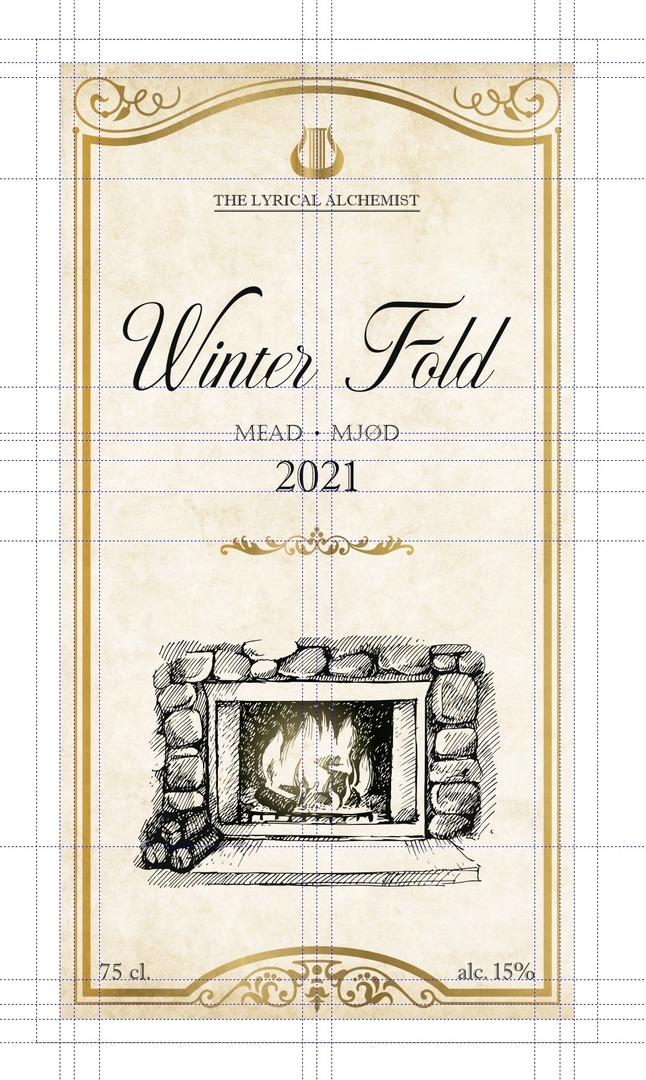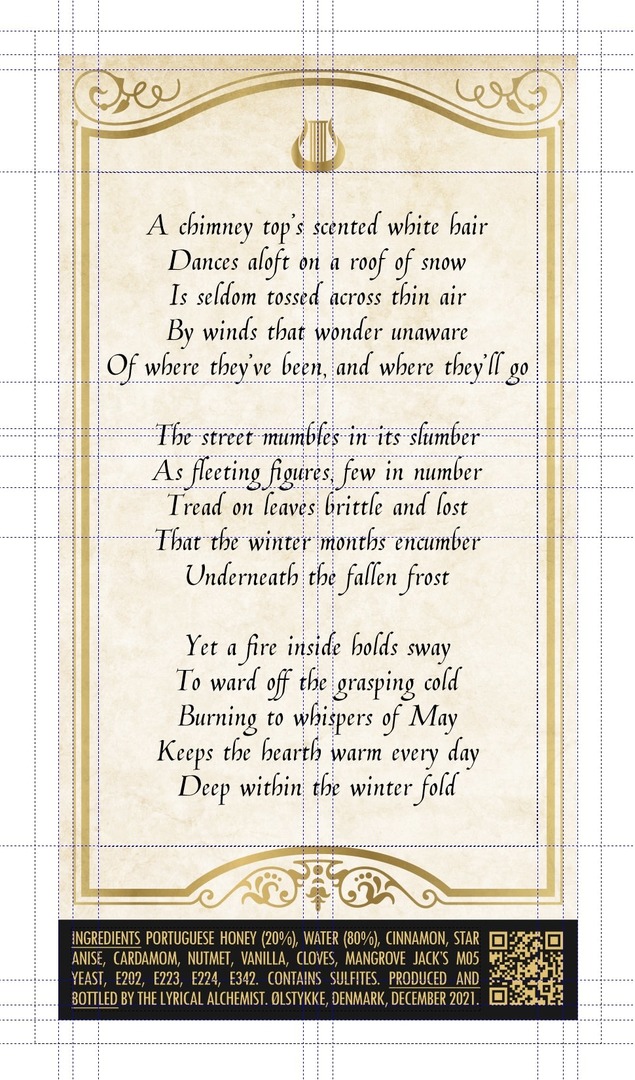THE LYRICAL ALCHEMIST
A journey of bottled expressions
Winter Fold
2021
Manifesto
The Lyrical Alchemist set out on its first journey to create a winter metheglin. A metheglin is a mead, i.e. honey wine, which has been flavored with some mix of herbs and spices, and so a winter metheglin is a mead enriched with seasonal winter spices, such as star anise, nutmeg and cloves. The goal was to start by defining a winter flavor profile and then mold it along the journey into a bottled expression of winter that one may relate to.
Did you know? - mead is the oldest alcoholic beverage known to mankind
Exordium
Inspired by various recipes of winter metheglins, a list of potential flavoring ingredients emerged: cinnamon, ginger, vanilla, cloves, cardamom pods, saffron, star anise, dried orange zest, nutmeg, raisins and oak chips.
Subsets of those ingredients were trialed by the brewing of teas, with then added honey. After just a few attempts, there was already an interesting formula to explore: 1 stick of cinnamon, 2 vanilla pods (opened), 1 star anise, 2 cloves, 2 cardamom pods (cracked) and a pinch of nutmeg.
Aside from the desired flavor profile, other variables such as sweetness, alcohol percentage, and density - also known as final gravity - were left undetermined at start, to allow for shaping the result throughout the process and at key milestones, where nosing, tasting and measurements would better counsel on the paths to take.
And so a creative journey that wove science, senses and lyrical imagination through the passing of time, started at the very beginning, with the three fundamental ingredients in the making of mead: honey, water and yeast.
Honey
Three different raw Portuguese honeys were used for this mead. Two were sourced from the beautiful region of Beira Baixa in the heart of Portugal, with one of them being specifically rosemary honey. The third was avocado honey from the Faro district of the Algarve region, in the south. All three were high in fructose, which can be observed by absent crystallization.
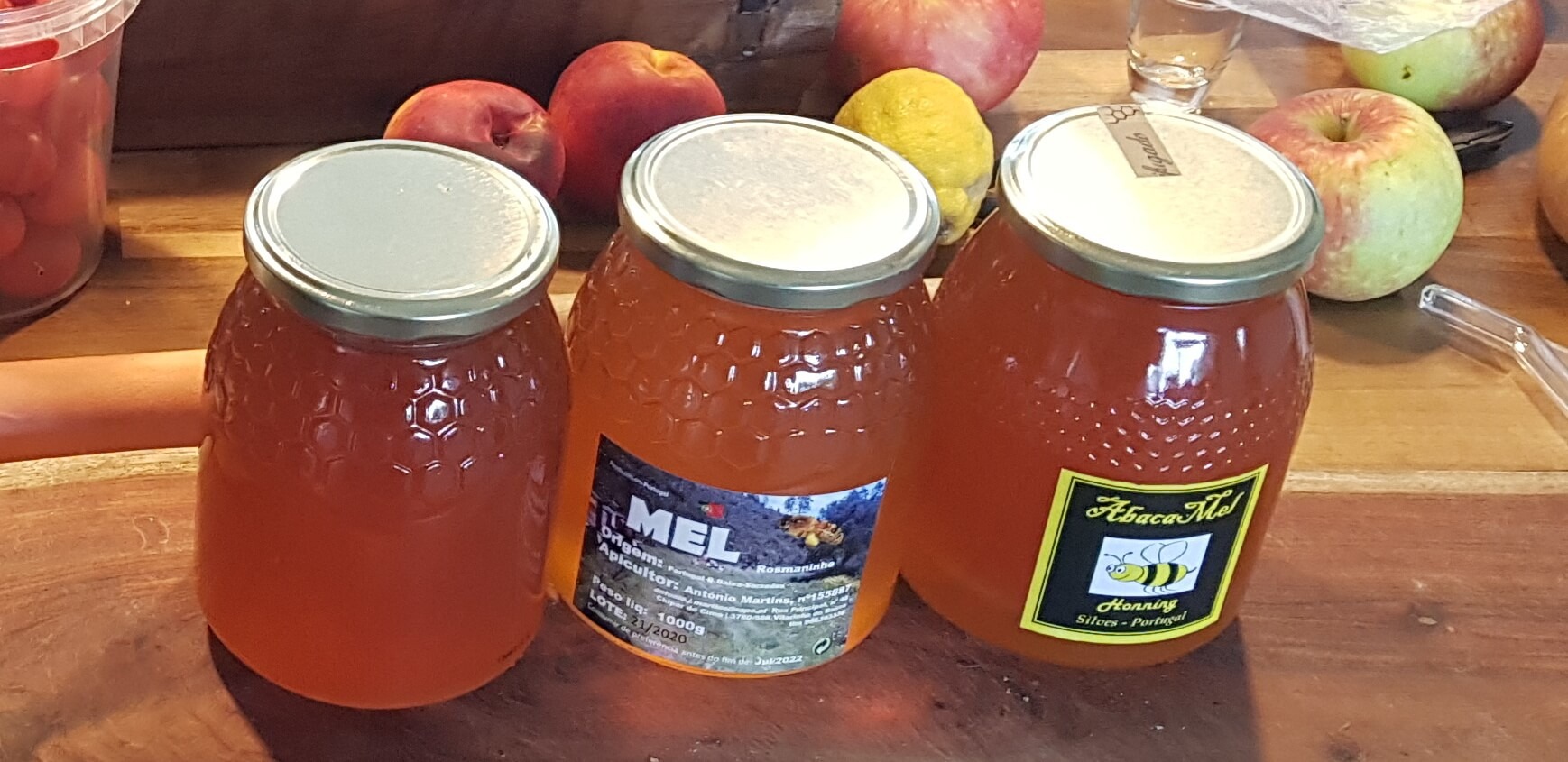
Water
When brewing mead, it is recommended to use water with high mineral content, also called hard water, which adds weight and flavor nuances to the brew, and aids the yeast cells in their most fastidious task.
As luck would have it, the tap water available to the Lyrical Alchemist is sourced from underground water in the municipality of Egedal - the valley of oaks - in Denmark, and is only oxygenated and filtered with sand filters at the local water plant, and it was measured to be over 25 °dH (German hardness degrees), which means it's very hard water.
Furthermore, since no chlorine is used in the treatment of any Danish water, there was no need to boil the water, which would have softened it by precipitating mineral content.


Tools
Simple tools for a simple task! Everything got cleaned with boiling water, to minimize risk of other yeasts joining the party.

Must
The must is a solution containing water, sugars and nutrients for the yeast to thrive in.
For this must, 3 Kg of honey - close to 2L - were mixed with 7.5L of water at 75C, and then kept for 10 minutes at around 70C, hot enough to pasteurize and eliminate wild yeast competition, while maintaining as much as possible of the honey's nutritional value.
Yeast nutrient E342 (Ammonium hydrogen phosphate) was also added here, particularly to provide phosphate and nitrogen, which are important for yeast growth and metabolism.



Gravity
Before pitching the yeast to the must, an important step is taken: to read the original gravity (OG). The OG is the relative density between the must and clear water, and tells us how much sugar is in the must, so we can assess the potential alcohol and later calculate how much sugar was consumed, and thereby estimate how much alcohol was produced in the process. A hydrometer is a tool used to measure points of density over 0 - which marks the density of clear water.
In this must, 98 points of gravity were measured at 30C. As the hydrometer was calibrated for 20C, the result was calculated and adjusted to 107.2 100.
And so as 7 points of OG is equivalent to about 1% alcohol if converted, the potential alcohol in this must was 15.3% 14.3%.
Note: the initial calculation of OG was wrong. It was 100 points of gravity, not 107.2, thereby yielding potential alc. 14.3%.


Yeast
Different yeasts greatly affect the result, by yielding different flavors, varying in alcohol tolerance, as well as in sensitivity to temperature and temperature shifts.
For this batch, Mangrove Jack's M05 - an easy going mead yeast with high alcohol tolerance and happy to ferment at room temperature - was pitched to the must at 27C. It was then stirred in with a drill with a special stirring attachment, also aerating the solution for a good primary fermentation start.



Primary
Primary fermentation is the period usually up to four weeks where the yeast eats most of all the sugar it can from the must.
The carboy was set to do its primary fermentation in a 16C room, on the cool side of the M05 yeast recommendation.
The fermentation started great with about a bubble per second in the first 4-5 days, and as expected slowed down from there.
13 days into primary, and gravity was measured at only 4 points left, meaning almost all the sugar had already been consumed. 5 days later, gravity was measured at 3 points, and 2 days later again at 3 points.
Upon tasting and consideration, the near-dry (1.003 gravity) result felt like a very good and fitting direction, and so it was time to rack onto secondary, halt any remaining fermentation and start flavoring.


Secondary
Once a primary completes, the mead is to be siphoned out of the current carboy and into a new secondary carboy, leaving behind fallen yeast cells at the bottom, that would otherwise give out bad flavors. This is called racking.
Acidity was measured at this point, at pH 3.4, which is a perfectly fine acidity for a mead and the taste confirmed that no action would be required on that regard.
Then, E202 (Potassium sorbate) was added to the bottom of the secondary carboy, just before racking, to stabilize the yeast cells by halting their reproduction.
Furthermore, E223 (Sodium metabisulfite) and E224 (Potassium metabisulfite) were also added here, to hinder further fermentation, and protect against oxidation as well as against other yeasts.


Flavoring
There are various methods for flavoring mead, that vary in control and balancing of flavors, as well as how each extracted flavor develops.
The chosen flavoring method was direct infusion using a tea bag containing the winter spices, added just after racking to secondary. This would allow for adjusting on the go, if a flavor would get too weak or predominant, but no adjustments were required.
After tasting samples every 3 to 4 days, a very satisfying infusion was achieved just after 10 days, the spices bag removed, and the mead - now a metheglin - finally allowed to just rest.



Poetry
With a curious and satisfying balance of the various spices, nosing and palate were able to guide the imagination to a moment of winter, a living frame from which to draw inspiration.
One could perhaps think the chosen spices would emerge warm, like sitting cozily by a fireplace with a warm mug of tea in hand. But the blend of flavors was more subtle, and a little fresher than expected.
So the idea of a cozy inside quickly vanished, and the thoughts drifted towards the mere promise of such coziness, like being out where true winter lies, where the footsteps of a few daring souls drift quickly about, crackling through snow and fallen leaves, while the coziness inside spills but hints of its wintery scents and comforting warmth.
A chimney top's scented white hair
Dances aloft on a roof of snow
Is seldom tossed across thin air
By winds that wonder unaware
Of where they've been, and where they'll go
The street mumbles in its slumber
As fleeting figures, few in number
Tread on leaves brittle and lost
That the winter months encumber
Underneath the fallen frost
Yet a fire inside holds sway
To ward off the grasping cold
Burning to whispers of May
Keeps the hearth warm every day
Deep within the winter fold
Identity
A well defined identity can direct and blend the various crafts in unison, like a maestro, as it works to bring a personality to the final product.
To better blend brewing and poetry at the journey's end, work had to first be done to create a unifying identity, of the grander journey and mission, a brand.
And so in an iterating process of trial and error, The Lyrical Alchemist got its name, its logo, and its label. And from the yet maturing flavor profile and a pinch of poetry, emerged its very first batch identity, the Winter Fold.
Bottling
Wine bottles, unlike Champagne bottles, cannot tolerate pressure build up inside, or they may blow. But if fermentation is stopped, with nearly all sugar consumed and with no back-sweetening, and furthermore if sulfites and potassium sorbate have been added to stabilize and halt any further fermenting, then it is safe to use wine bottles.
As this metheglin was intended to be given out as Christmas gifts, it was bottled young, at only 2 months.
The style of wine bottle chosen was a clear glass Bordeaux style wine bottle, with elegant shoulders and a good view of its contents, to let the clarity and colour of the mead shine through.
The bottles were first washed and dried, then filled using an automatic siphon, for ease of transfer to leave the precipitated yeast behind, and also with a bottling attachment for avoiding spill. Finally, they were corked with plastic capped corks and sealed with bottle capsules, that were then shrank using a heat gun. The only thing missing now was labeling.



Labeling
The labeling step is the apotheosis of all the crafts involved, as they blend at the journey's end, composing the brewing of mead, the writing of poetry and the shaping of a visual identity into not only a product and an experience, but also a piece of art.


Winter Fold
a bottled expression of winter
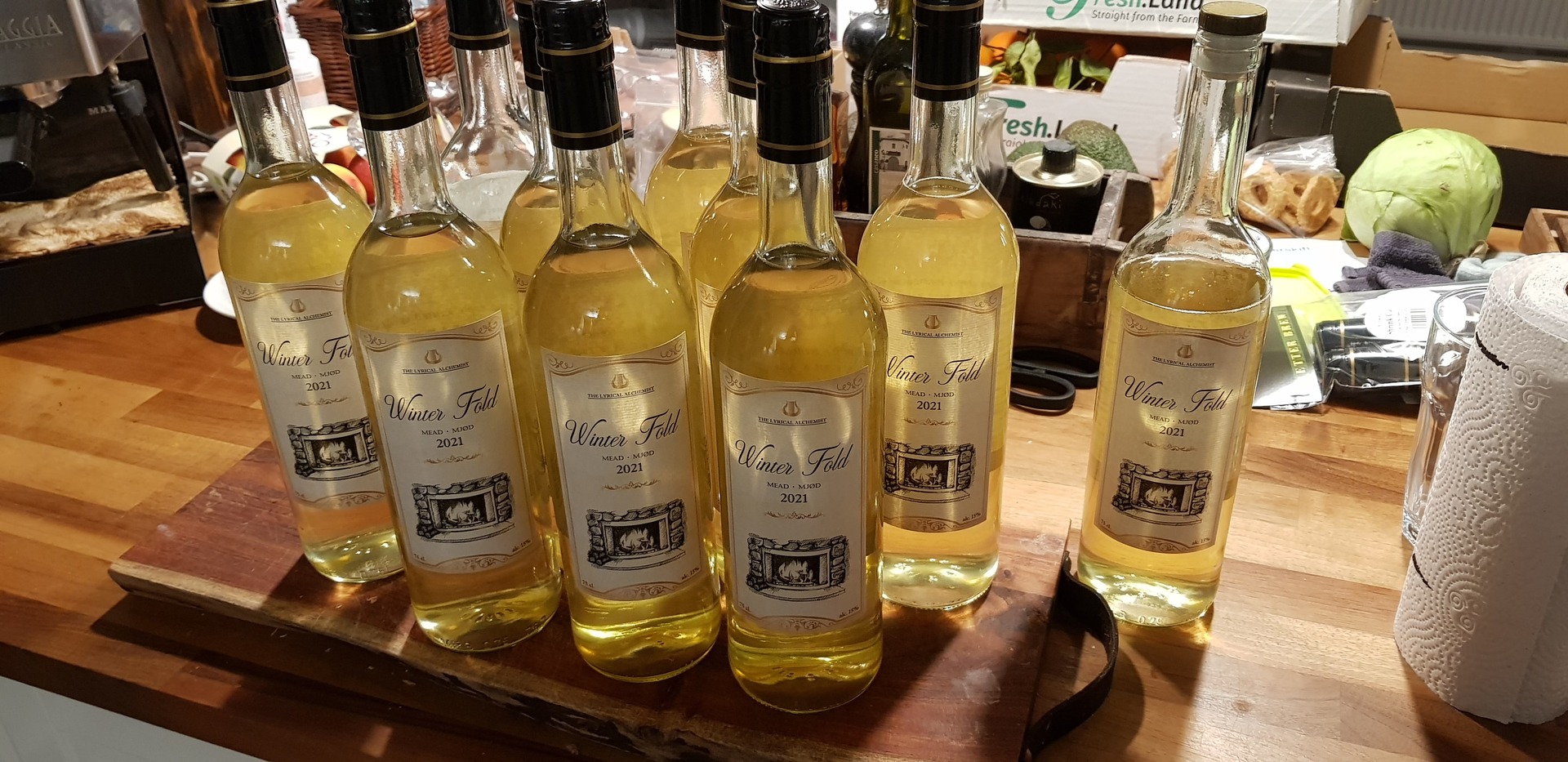
THE LYRICAL ALCHEMIST
Copyright © 0, The Lyrical Alchemist, Ølstykke, Denmark. All rights reserved
